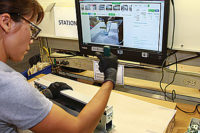The value of standard work is clear: improved productivity and quality. With standard work, the process is well documented, its yield is high, its cycle time is rock solid, and everyone has been trained to do it. It worked well once, so we do it again and again.
Your processes are the bedrock of your business, and standard work locks them down so they can deliver value day-to-day and year-to-year. A lot of good thinking went into your processes, and standard work wrings value from that thinking every time it’s followed. Standard work leverages your best thinking, but it is yesterday’s best thinking.
Standard work is littered about us—value stream maps, decision trees, process flow diagrams— and our metrics are co-developed to maximize compliance. These metrics, in a standard work way, are automatically plotted (in a standardized format, of course). Outliers are flagged by statistical filters and posted for all to see. They’re called control charts for a reason.
An even more powerful standardization method is the visual standard. In the factory, for example, lines on the floor define where to walk—stay within them and you’re safe. In the conference room, align the chairs in a neat row and you’ll fit right in. In the back office, there are even pictures of your personal workspace tightened up as it should be. (That’s a bridge too far!) The message is clear: Color within the lines and your conformity will be recognized.
Yes, there’s real power in standard work, but its power is indiscriminant. It locks down goodness. It locks down newness. Reminded constantly about standard work’s infinite goodness, our welldesigned processes become deep grooves of sameness worn into the bedrock of the organization. Taken too far, standard work creates a static just-follow-the-process mindset that leads to cultural staleness. In our ever-changing world, static can’t be tolerated.
Standard work is time-bound. Before standard work was standard, it was nonstandard. At some point in company history, today’s standard work was new. It follows that today’s standard work won’t be tomorrow’s; it will be old. It sounds silly to say, but the point is often lost: Over time, standard work is replaced with nonstandard work. That’s how things evolve and improve. The speed of improvement is defined by the ratio between standard and nonstandard work.
It’s clear to me the balance has tipped too far toward standard work. (How many training hours have you spent on standard work? How many on nonstandard work?) You’re not hearing it, but folks are holding back ideas because the worn path of standard work is too deep. The mass of standard work is squeezing the creativity and motivation out of your people. And they won’t tell you about the stifling feeling and poor morale because they know regardless of the question, the answer is standard work.
Nonstandard work needs (and deserves) your advocacy. At your next team meeting, apologize for the frenzied pursuit of standard work, then ask an open-ended question like “What have you always wanted to try?” After the third time you ask, and they finally believe you’re serious, try it. Try it on a small scale, but try it. You’ll be amazed at your team’s new found vigor and interest. The idea doesn’t even have to work. You asked, you listened, and you tried their idea. And you’re on your way.
Standard work is powerful and valuable, but it has a dark underbelly that blocks nonstandard work. To keep a healthy balance, embrace its yin and yang, and you’ll stand out.
Editor’s note: Mike Shipulski is a leading authority on lean manufacturing, product development, and design for manufacturing and assembly. His column will appear every other month, alternating with Austin Weber’s “On Campus.” E-mail Mike with comments via mike@ shipulski.com or follow his blog at www.shipulski.com. Standard work locks down newness. Mike Shipulski, Ph.D. www.shipulski.com



